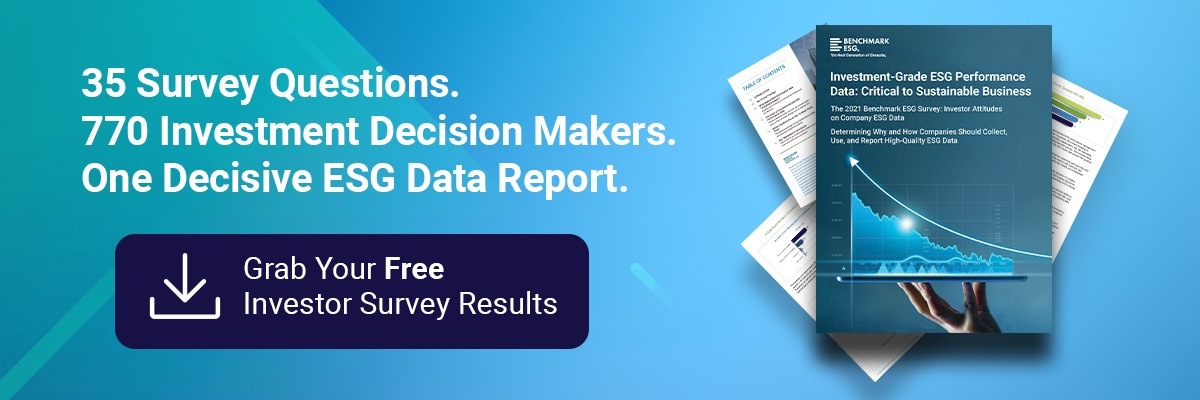Assembling the data for a sustainability report is not easy. ESG directors are often tasked with managing hundreds of data points across multiple teams and sites across the globe. One company told Benchmark it has over 100 stakeholders when designing, implementing, and executing their ESG data collection processes and the sustainability performance management efforts they to support.
The complexity doesn’t stop there. ESG directors must also ensure the contemporaneity, veracity, and provenance of their sustainability data. That means administrators must regularly update, substantiate, and audit their data before they can release it.
Complexity breeds chaos. In this case, ESG directors end up with “Spreadsheet Madness.” We regularly talk with teams who are managing their organizations’ ESG programs with a handful of different spreadsheets across multiple, distinct business units. They manually administer data repositories that are oftentimes updated by anonymous users with inconsistent metrics. That’s a recipe for errors and delays. As investors, executives, and now customers increasingly demand “investment grade data,” this is a vulnerability. Without proper quality assurance, it is difficult to ensure that the data is reliable.
There’s a better method. Teams that have created a cloud-based system of record for their ESG data only have minimal updates once their ESG data architecture is defined and KPIs are assigned to the appropriate stakeholders. With email notifications and progress tracking, ESG administrators can remotely access the data they need to determine which ESG performance areas need to be addressed, what KPIs need to be updated, and what interventions to deploy. Since every step of the process is registered by the system, data verification and auditing are much easier to manage.
Simplicity limits chaos, so teams with more uniform digital solutions are more organized and nimbler. With a well-structured and automated digital system of record, ESG directors can pursue more challenging targets with the time and effort they save on data collection alone.
No two companies are identical, but simplicity can help all of them. Here are some of the tools that can make ESG directors’ work more straightforward:
Materiality Assessments
Embark on your ESG journey with confidence
Understanding your organization’s impact and financial risk associated with different ESG metrics is a critical step for understanding how ESG affects your long-term financial performance and what your team can do to have a better impact on the world. Risk assessments and inputs from a diverse group of stakeholders can inform your ESG team on which issues demand highest priority and where your target-setting can have the biggest results.
Data Collection Workflows
Ditch the spreadsheets, automate ESG data collection, and assign ownership of KPIs
Data collection is often one of the most complicated tasks for ESG teams. But a digital solution with automated workflows and KPI assignments can allow data collection to be assigned to the subject matter experts who have the data most readily available. And direct API connections with HR management systems, utility providers, and other external sources can remove the human element, reducing errors and saving time.

ESG Project Analysis
Evaluate the effectiveness of your sustainability management and strengthen your bottom line
Many companies are flying blind when they set ambitious ESG targets, such as an aggressive emissions reduction goal. Having a comprehensive set of tools to improve emissions calculations and more accurately project the ESG impact of sustainability projects can help you gauge the effects of key decisions. From upgrading facility lighting systems to resiting product manufacturing to a local supplier with better workplace standards, pairing cloud-supported data collection solutions with data analytics and visualization capabilities can guide enterprise end-users to new cost-saving and revenue-driving opportunities.
Centralized Data Repository
Produce and report the investment-grade ESG performance data needed to meet programmatic goals, maximize financial performance, and fulfill ESG data reporting obligations
On top of reporting to multiple frameworks, ESG teams are being bombarded with requests from investors, rating agencies, and customers that are managing their supply chains. Without a cloud-based system of record, ESG teams take valuable time organizing responses when they could be improving their organization’s sustainable performance. Having investment-grade ESG data at their fingertips allows ESG teams to easily facilitate ESG disclosures and respond to external stakeholders with reliable, contemporary data.
How Benchmark’s ESG Disclosure Director Helps
ESG platforms that require you to manually input your data and report to major frameworks are a dime a dozen. What ESG teams need are systems that simultaneously simplify and enhance ESG data collection and management processes from start to finish, creating a well-oiled machine that lets them work on the projects that generate value and produce a positive impact on the world. If you’re interested in seeing how a cloud-based digital ESG solution can make your life easier, sign up for a free 3-month trial today.




